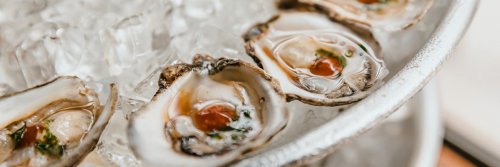You either love them or hate them; there isn't an in between on the subject of eating oysters. For the lovers of oysters, known as ‘ostreophiles' (Greek words 'ostreon’ for oyster and ‘philos’ loving), that mouthful of heaven is sublime and sensual. Even the act of preparing an oyster for eating—detaching it from the shell with a little fork, maybe adding a vinaigrette of some description, lemon juice or hot sauce for a spicy bite, then holding your head back to let it slip into your mouth complete with juices, is an exercise in devotion. A chew or two and then swallowing. Often followed by a sigh of appreciation, a perfect oyster will send shivers up your spine in delight.
Put in the category of a luxury food item, oysters were gobbled down by the ancient Romans by the bucket load at raucous orgies, and in medieval Europe, they were dished up en masse at banquets and feasts. It's believed that King Henry IV of England scoffed more than 400 oysters in one sitting, and his grandson Louis XIV had them delivered fresh daily to Versailles or wherever he happened to be in France. It’s little wonder that France is the biggest consumer and exporter of oysters in Europe. And, the United States coastal areas have long been bastions of oyster harvesting and processing over centuries. Old wives' tales or fanciful beliefs, oysters are aphrodisiacal foods in the libido boosting list, despite there being no scientific proof, alongside chocolate, ginseng, and alcohol.
The ’best’ oysters depend on personal preference, but where to find them is down to regions known for having exceptional oyster mouthfuls of minerally goodness that taste like the sea. There are subtle differences in the taste of oysters depending on their environment. To give their homes a scientific token like wine and its 'terroir', oyster environments are labelled 'merrior'. It all comes down to what the oyster is eating, the salinity, and the temperature of the water it's growing in. The rainfall and season also have an impact on the taste of an oyster—winter oysters are generally sweeter than summer ones.
From raw to grilled, baked, fried, or swimming in a mouthwatering oyster chowder, these mouthfuls of ecstasy will leave you hankering for more. With over 150 varieties of oysters in the world, they have been on the human food menu since the Stone Age, when Palaeolithic communities would roast their oysters over a fire. If you believe in Greek myths, the Goddess of Love, Aphrodite, was said to have emerged on a giant oyster shell from the ocean.

Australia
The Sydney Rock and the Pacific, both having subtle differences, are the two main oyster varieties of Australia. Rich and creamy, small Sydney Rock oysters are indigenous to Australia and have a more metallic hint in their flavor. While, Pacific Oysters, native to northeast Asia and introduced from Japan in the 1940s, are salty, briny, and plump. The 'Apple Isle', aka Tasmania, has a chubby oyster 'Gigas' with a definite seaweed-flavored saltiness, combining a crisp aftertaste of gentle sweetness. Be aware that these are big boys if you only like small oysters.
France
The land of discerning gourmands with more than 2,000 miles of coastline who adore these salty critters. You will find them on the menu at brasseries and bistros around the country with Speciales Gillardeau oysters applauded as the best for their tender bodies and rich savory flavor. Gillardeau oysters are found in the Marennes-Oléron basin, which is the famous oyster production hub of Europe, along with other varieties such as Fine de Claire Verte, Fine de Claire, Pousse en Claire, and Spéciale de Claire. The revered 'Belon' oyster is cultivated in the Belon River, Brittany. And, Kys oysters are to be found on the southern coast of Brittany. It's best to go directly to the source for the freshest oysters available.
Japan
‘Senpoushi' oysters are world famous, with a long and shallow body of creamy meat and a touch of salty essence. These are not for the faint-hearted as they are huge, and when eating them raw, you should remove the excess water, or it will be too salty. There are three famous oyster cultivating areas in Japan: Hiroshima, the largest producer, the Sanriku Coast with its cheek-to-cheek oyster shacks, and Hokkaido, where you will find Akkeshi and Shiriuchi oysters.
Other destinations where you can shuck and slurp on oysters include Brazil for a salty Santa Catarina with a caipirinha, and the Kumiai oyster from Baja California Sur, Mexico. A rare treat is a Namibian Pacific oyster before heading off on a safari, while Jersey oysters found in the Royal Bay of Grouville grow in some of the cleanest seawater in Europe.
The world really can be your oyster!
Gail Palethorpe, a self proclaimed Australian gypsy, is a freelance writer, photographer and eternal traveller. Check out her website Gail Palethorpe Photography and her Shutterstock profile.















